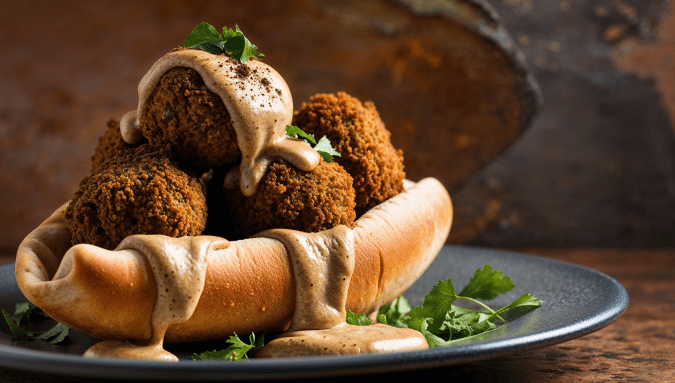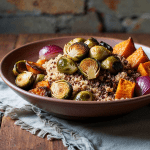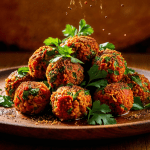Falafel is a popular Middle Eastern dish made from ground chickpeas (or fava beans), herbs, and spices, formed into balls or patties and deep-fried to a crispy perfection. Often served in pita bread with a variety of toppings and sauces, falafel is not only delicious but also a great source of plant-based protein.
Ingredients
For the Falafel:
- Chickpeas: 1 cup dried chickpeas (soaked overnight)
- Onion: 1 small, finely chopped
- Garlic: 2-3 cloves, minced
- Fresh herbs: A handful of parsley and cilantro, chopped
- Spices: 1 tsp cumin, 1 tsp coriander, salt, and pepper to taste
- Baking soda: 1/2 tsp
- Flour: About 2-4 tbsp (to bind)
- Oil: For deep frying
For the Tahini Sauce:
- Tahini: 1/2 cup
- Lemon juice: From 1 lemon
- Garlic: 1 clove, minced
- Water: To thin out the sauce
- Salt: To taste
Preparation Steps
Making the Falafel:
- Soak the Chickpeas: Rinse the dried chickpeas and soak them in water overnight. They should double in size.
- Blend the Mixture: Drain the chickpeas and add them to a food processor with onion, garlic, herbs, spices, and baking soda. Pulse until you achieve a coarse mixture.
- Form the Balls: Transfer the mixture to a bowl. If it’s too wet, add flour gradually until it holds together. Shape into small balls or patties.
- Heat the Oil: In a deep pan or fryer, heat oil to about 350°F (175°C).
- Fry the Falafel: Carefully drop the falafel balls into the hot oil in batches. Fry until golden brown (about 3-4 minutes). Remove and drain on paper towels.
Making the Tahini Sauce:
- In a bowl, combine tahini, lemon juice, minced garlic, and salt.
- Gradually add water until you reach your desired consistency (smooth and pourable).
Serving Suggestions
To serve falafel:
- Warm pita bread or flatbreads.
- Fill with falafel balls.
- Drizzle with tahini sauce.
- Add toppings such as lettuce, tomatoes, cucumbers, pickles, or even spicy sauces for an extra kick.
Popular Variations of Falafel
Falafel varies significantly across different regions, each with its unique twist:
- Egyptian Falafel (Ta’ameya): Made primarily from fava beans, this version is often flavored with herbs like parsley and cilantro, resulting in a vibrant green color. It’s typically served with pita and a salad of tomatoes and cucumbers.
- Palestinian Falafel: Usually made from chickpeas, this variant incorporates garlic, onions, and fresh herbs. It is often accompanied by hummus and pickled vegetables.
- Lebanese Falafel: A mix of chickpeas and fava beans gives this falafel a distinct texture. It is seasoned with spices such as cumin and coriander and served with tahini sauce and fresh salads.
- Turkish Falafel: Known as acma, this variation includes bulgur along with chickpeas, providing a unique flavor profile. It’s commonly served with yogurt sauce.
- Mexican-inspired Falafel: Incorporating ingredients like jalapeños and spices typical of Mexican cuisine, this fusion version adds a different twist to the traditional recipe.
How to Make Authentic Falafel at Home
To prepare authentic falafel, follow these steps:
Ingredients
- Chickpeas: 1 cup dried chickpeas (soaked overnight)
- Onion: 1 small, finely chopped
- Garlic: 2-3 cloves, minced
- Fresh herbs: A handful of parsley and cilantro, chopped
- Spices: 1 tsp cumin, 1 tsp coriander, salt, and pepper to taste
- Baking soda: 1/2 tsp
- Flour: About 2-4 tbsp (to bind)
- Oil: For deep frying
Instructions
- Soak the Chickpeas: Rinse and soak the dried chickpeas overnight in water.
- Blend the Mixture: Drain the chickpeas and add them to a food processor with onion, garlic, herbs, spices, and baking soda. Pulse until coarsely blended.
- Form the Balls: Transfer the mixture to a bowl. If too wet, add flour until it holds together. Shape into small balls or patties.
- Heat the Oil: Heat oil in a deep pan to about 350°F (175°C).
- Fry the Falafel: Fry in batches until golden brown (about 3-4 minutes). Drain on paper towels before serving.
Health Benefits of Eating Falafel
Falafel offers several health benefits:
- High in Protein: Made primarily from chickpeas or fava beans, falafel is an excellent source of plant-based protein.
- Rich in Fiber: The legumes provide dietary fiber, promoting digestive health.
- Vitamins and Minerals: Ingredients like herbs contribute vitamins A and C, as well as essential minerals such as iron and magnesium.
- Low in Saturated Fat: When baked instead of fried, falafel can be a low-fat option suitable for heart health.
Origin of Falafel
Falafel is believed to have originated in Egypt, where it was traditionally made from fava beans. Over time, it spread throughout the Middle East, particularly becoming popular in Palestinian cuisine where chickpeas became the main ingredient. The dish has since evolved into various regional versions across countries like Lebanon and Turkey.
Common Toppings for Falafel in a Pita
When served in pita bread, falafel can be topped with various ingredients:
- Tahini Sauce: A classic accompaniment that adds creaminess.
- Hummus: Often used as a base layer inside the pita.
- Fresh Vegetables: Lettuce, tomatoes, cucumbers, and onions are common additions.
- Pickled Vegetables: Adds tanginess and crunch.
- Hot Sauce or Spicy Sauce: For those who enjoy heat.
These toppings enhance the flavor profile while providing additional nutrients to the meal.
Falafel is not only a tasty vegetarian option but also a versatile dish that can be enjoyed in various ways, whether as a sandwich in pita bread or as part of a mezze platter. Its rich flavors and satisfying texture make it a favorite among many food lovers around the world! Enjoy your homemade falafel experience!












